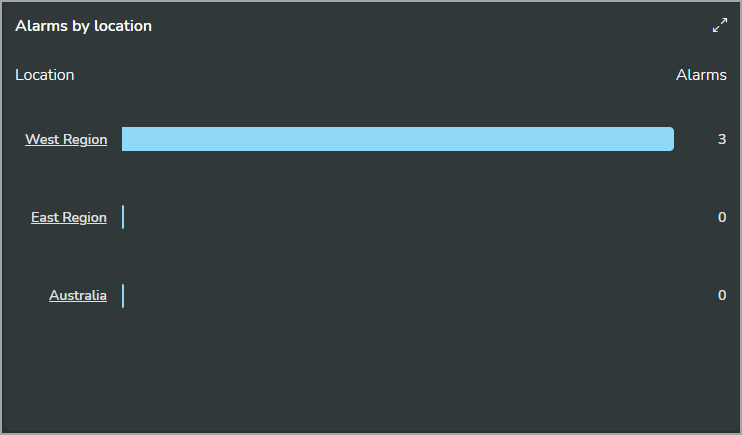Alarming
NOTE: The functionality displayed in this topic might not be the same as what you see for your organization. Your Energy Hub feature plan subscription determines which functions and features are available for your organization. For feature plan details, see Feature plans.
In Energy Hub, you can see alarms, acknowledge alarms, and receive alarm notifications.
| Overview |
| Configuring alarming |
| Viewing and managing alarms |
Use alarming to stay informed about exceptional operating conditions in your facility.
An alarm is the annunciation of an exceptional condition, such as a measurement exceeding a defined value or the interruption of a process. An alarm can be raised by a monitoring device, a communication gateway, or the Energy Hub software.
There can be many types of alarms, such as power quality alarms, energy management alarms, asset monitoring alarms, and others. Which alarm types are available for your organization in Energy Hub depends on the monitoring device types in your facility, the device configurations, the Energy Hub software alarm configuration, and the Energy Hub feature plan you have subscribed to. For list of software alarms in Energy Hub, see Energy Hub alarms (list).
Different applications support different types of alarms. See Energy Hub alarms for a list of application specific alarms.
You can see alarm information in Inbox and in Investigate. Inbox shows alarms for your entire organization. Investigate, in the Asset view, shows alarm information for the item that you select in the organization tree. In both, you can see alarm lists and individual alarm details.
NOTE: Inbox only shows alarms for the alarm categories and alarm priorities that you have selected in the notification settings.
NOTE: Investigate shows all alarms for the location or equipment that you select in the organization tree, independent of the notification settings.
The following table shows the alarm details that are available:
| Property | Description |
|---|---|
|
Category |
A high level classification of the alarm. |
|
Type |
A low level classification of the alarm. |
|
Detail |
Information about the device or measurement that is being alarmed on. |
|
Priority |
Importance of the alarm. |
|
State |
Possible states include: Active or Inactive, Acknowledged or Unacknowledged |
|
Start time |
The date and time when the alarm went active. |
|
End time |
The date and time when the alarm went inactive. |
|
Duration |
This shows: Active when the alarm is active, Instantaneous (for an instantaneous alarm, such as a power quality transient alarm), the length of time the alarm was active for an inactive alarm. |
See Functions and user interfaces (UIs) and Alarms summary for examples of alarm information displays in Inbox and Investigate.
You can acknowledge active alarms. When you acknowledge an alarm, Energy Hub records the user name of the logged-in user, the date and time of the acknowledgment, and an optional comment.
After you have acknowledged an alarm, it stays acknowledged until the next time it goes active. At that point, it is reset to unacknowledged and is ready to be acknowledged again. An alarm stays unacknowledged until you acknowledge it.
Acknowledging alarms is a good practice to show that the alarm is being managed and to record relevant information for future reference.
Energy Hub can send notifications about alarm state changes to your Schneider ID email account, and it can send push notifications to your mobile device through the Energy Hub mobile app. You configure these options in notification settings.
NOTE: Energy Hub only sends alarm notifications for organizations with active subscriptions for the relevant applications.
Alarm notification email limits
There is a limit on the number of alarm notification emails Energy Hub sends for an organization per calendar month. This limit is based on the number of device credits for the organization.
Available emails for an organization per month = number of device credits × 100
For example, an organization with 15 device credits has a maximum of 1500 (15 × 100) alarm notification emails available per calendar month.
Energy Hub sends out reminder emails when 75% and 100% of the email limit has been reached. After the limit has been reached, Energy Hub does not send or queue alarm notification emails for the rest of that month. Email counts are reset at the beginning of each calendar month, so the full number of alarm notification emails is available again for the organization for the new month.
There is no limit on the number of push notifications Energy Hub can send to mobile devices.
Notification settings
Notification settings control for which alarms Energy Hub sends email notifications and mobile push notifications. You can customize these settings based on alarm category and alarm priority.
NOTE: Energy Hub sends notifications for certain types of alarms regardless of the notification settings. To find out if you can disable notifications for an alarm type, see Energy Hub alarms (list).
NOTE: The limit for alarm notification emails is 100 emails per device credit per month. For more information, see Alarm notification email limits.
The following table shows the available alarm categories and alarm priorities:
| Setting | Options |
|---|---|
|
Alarm category |
Asset Monitoring, Diagnostics, Energy Management, General, Power Quality |
|
Alarm priority |
Low, Medium, High |
See Editing notification settings for details on how to change the settings.
In Energy Hub you can configure software alarms and alarm notifications. Device-based alarms are configured outside of Energy Hub, on the monitoring devices or on the communication gateways.
Alarming prerequisites
Before configuring alarming, verify that:
- You have a subscription to a feature plan that includes the alarms you are interested in.
- Power monitoring devices are installed in your facility and configured to provide the alarms that you are interested in.
- (For water and gas alarms) Water and gas monitoring devices are installed in your facility.
- The monitoring devices are connected to communication gateways, for example Site Server or Panel Server, that are sending alarm data to Energy Hub over the internet.
- The communication gateways have been added to your organization in Energy Hub.
- The software alarms that you are interested in are configured in Energy Hub.
- In Energy Hub, go to Investigate and select the Asset view or Energy view.
- In the organization tree, select the location, device, or equipment that you want to create the alarm rule for.
NOTE: Some alarms only apply to certain locations, devices, or equipment. For information on the applicability of alarms, see Energy Hub alarms (list)
- In the information panel for the location, select the Alarm Settings tab. A list of existing alarm rules for this location displays.
- On the alarm settings tab, select Add Alarm Rule. The Create new alarm rule panel displays.
- In Create new alarm rule, in the Alarm Type section, select the type of alarm rule you want to create. Select Next.
- In Create new alarm rule, in the Setpoint section, define parameters such as aggregation interval, alarm priority, and alarm ON threshold value. Select Next.
- In Create new alarm rule, in the General section, define a name for the new alarm rule.
- (Optional) In Create new alarm rule, in the General section, disable the new alarm rule if you do not want it to take effect immediately.
NOTE: You can enable or disable alarm rules at any time on the alarm settings tab in the information panel for the location.
- Select Finish.
- In Energy Hub, go to Investigate and select the Asset view or Energy view.
- In the organization tree, select the location that you want to edit the alarm rule for.
- In the information panel for the location, select the Alarm Settings tab. A list of existing alarm rules for this location displays.
- Find the alarm rule that you want to edit.
- From the options menu (three dots) for the alarm rule, select Edit. The Edit alarm rule panel displays.
- In Edit alarm rule, in the Setpoint section, update the alarm rule with the changes that you want to make.
NOTE: You cannot change the alarm type of an existing alarm rule.
- Select Next to move to the General section.
- (Optional) Update the alarm rule name.
- Select Finish.
- In Energy Hub, go to Investigate and select the Asset view or Energy view.
- In the organization tree, select the location that you want to enable or disable the alarm rule for.
- In the information panel for the location, select the Alarm Settings tab. A list of existing alarm rules for this location displays.
- Find the alarm rule that you want to enable or disable.
- Toggle the slider control for this alarm rule to enable or disable the alarm rule.
TIP: You can also enable or disable an alarm rule when editing the rule or when creating a new rule.
- In Energy Hub, go to Investigate and select the Asset view or Energy view.
- In the organization tree, select the location that you want to delete the alarm rule for.
- In the information panel for the location, select the Alarm Settings tab. A list of existing alarm rules for this location displays.
- Find the alarm rule that you want to delete.
- From the options menu (three dots) for the alarm rule, select Delete.
- In Energy Hub, go to Setup > Notification settings.
- In the configuration panel, customize the available settings to meet your needs.
View alarm information for your electrical equipment and your energy infrastructure and stay informed about exceptional operating conditions in your facility. Acknowledge alarms to manage them and to record relevant information.
NOTE: Always consider the Safety Precautions when using information provided by Energy Hub for decision making.
Before you can view and manage alarms you need to configure Alarming.
To view alarms in Inbox:
- In Energy Hub, go to Inbox.
- View a list of alarms in the list panel.
TIP: To set the date range for the displayed information, use the date range selector in the Views navigation bar, in Investigate.
- Select an alarm in the list panel and view details for the selected alarm in the details panel.
To view alarms in investigate:
- In Energy Hub, go to Investigate and select Asset view.
- In the navigation panel, find and select the item in the organization tree that you want to view alarms for.
- View alarms for the item in the display panel.
TIP: To set the date range for the displayed information, use the date range selector in the Views navigation bar, in Investigate.
See Functions and user interfaces (UIs) and Alarms summary for examples of alarm information displays in Inbox and Investigate.
- In Energy Hub, go to Investigate and select the Asset view or Energy view.
- In the organization tree, select the location that you want to view existing alarm rules for.
- In the information panel for the location, select the Alarm Settings tab. A list of existing alarm rules for this location displays.
To acknowledge an alarm:
- In Energy Hub, find the alarm you want to acknowledge, for example, in Inbox or in the Investigate > Asset view.
- Select the alarm. The alarm details display, either in the details panel in Inbox, or in a dialog in Investigate.
- In the alarm details, find the alarm acknowledgment section.
- (Optional) In the alarm acknowledgment section, enter a comment to be recorded with the acknowledgment.
- Select Acknowledge to acknowledge the alarm.
NOTE: This acknowledges the latest instance of this alarm and any previously unacknowledged instances.
See Alarms summary for an example of the alarm details display with alarm acknowledgment section.
This display shows alarms for the location, equipment, or device selected in the organization tree. The alarm information includes an alarms list, alarm counts and alarm status. Select an alarm from the list to see alarm details. Use the alarms filter (funnel icon) to filter the list based on alarm priority, alarm state, or alarm category.
TIP: Select the arrows icon in the top right corner to maximize the display.
Examples (shown in dark mode and in English language):
Alarms summary
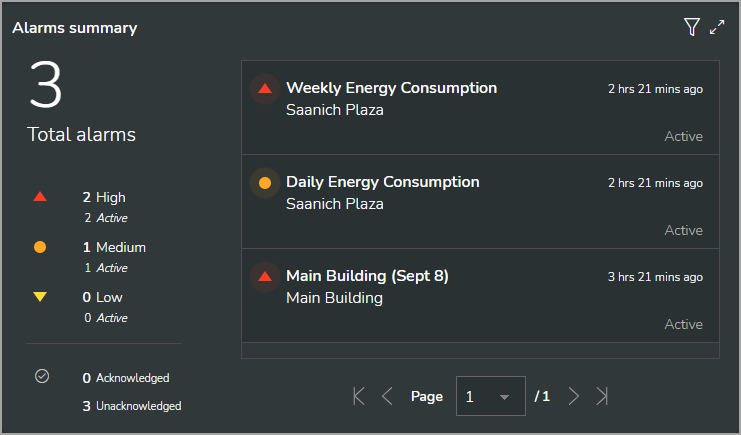
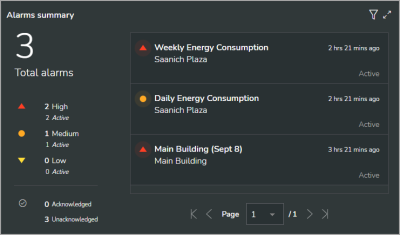
Alarm details
Details for the alarm selected from the alarm list. Select the investigate alarm source link in the details display to open the location, equipment, or device that generated the alarm. Select Acknowledge, to acknowledge the alarm and enter an optional comment.
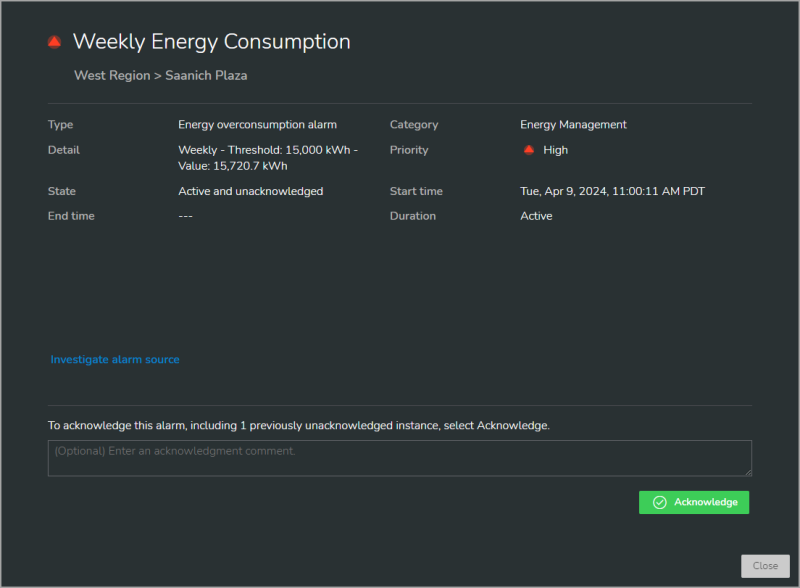

Alarm list filter
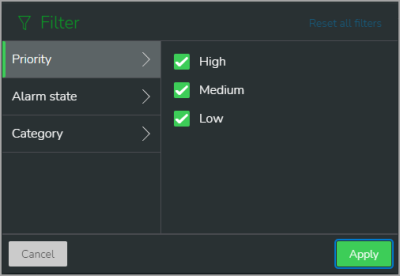
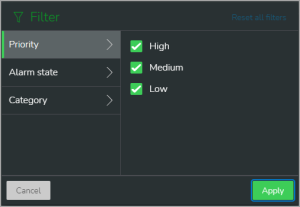
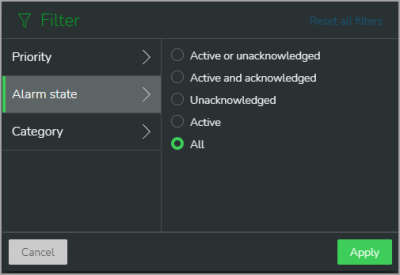
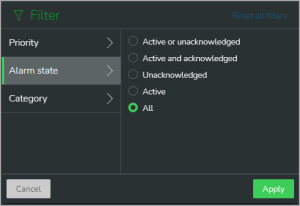
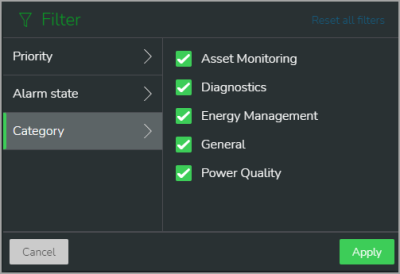

This display shows the number of alarms for the child locations of the selected location. The chart is ordered by alarm count, with the highest alarm count at the top.
NOTE: This display shows a maximum of 10 locations.
TIP: Select the arrows icon in the top right corner to maximize the display.
Example (shown in dark mode and in English language):
